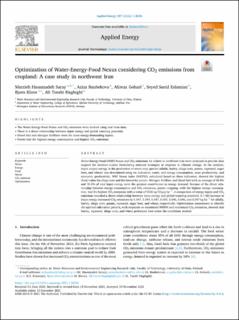Optimization of Water-Energy-Food Nexus considering CO2 emissions from cropland: A case study in northwest Iran
| dc.contributor.author | Saray, Marzieh Hasanzadeh | |
| dc.contributor.author | Baubekova, Aziza | |
| dc.contributor.author | Gohari, Alireza | |
| dc.contributor.author | Eslamian, Seyed Saeid | |
| dc.contributor.author | Kløve, Bjørn | |
| dc.contributor.author | Haghighi, Ali Torabi | |
| dc.date.accessioned | 2022-11-04T18:58:08Z | |
| dc.date.available | 2022-11-04T18:58:08Z | |
| dc.date.created | 2022-05-06T15:04:01Z | |
| dc.date.issued | 2021-12-13 | |
| dc.identifier.citation | Applied Energy. 2022, 307 . | en_US |
| dc.identifier.issn | 0306-2619 | |
| dc.identifier.uri | https://hdl.handle.net/11250/3030263 | |
| dc.description.abstract | Water-Energy-Food (WEF) Nexus and CO2 emissions for a farm in northwest Iran were analyzed to provide data support for decision-makers formulating national strategies in response to climate change. In the analysis, input–output energy in the production of seven crop species (alfalfa, barley, silage corn, potato, rapeseed, sugar beet, and wheat) was determined using six indicators, water, and energy consumption, mass productivity, and economic productivity. WEF Nexus index (WEFNI), calculated based on these indicators, showed the highest (best) value for silage corn and the lowest for potato. Nitrogen fertilizer and diesel fuel with an average of 36.8% and 30.6% of total input energy were the greatest contributors to energy demand. Because of the direct relationship between energy consumption and CO2 emissions, potato cropping, with the highest energy consumption, had the highest CO2 emissions with a value of 5166 kg CO2eq ha−1. A comparison of energy inputs and CO2 emissions revealed a direct relationship between input energy and global warming potential. A 1 MJ increase in input energy increased CO2 emissions by 0.047, 0.049, 0.047, 0.054, 0.046, 0.046, and 0.047 kg ha−1 for alfalfa, barley, silage corn, potato, rapeseed, sugar beet, and wheat, respectively. Optimization assessments to identify the optimal cultivation pattern, with emphasis on maximized WEFNI and minimized CO2 emissions, showed that barley, rapeseed, silage corn, and wheat performed best under the conditions studied. | en_US |
| dc.language.iso | eng | en_US |
| dc.publisher | Elsevier Ltd. | en_US |
| dc.rights | Navngivelse 4.0 Internasjonal | * |
| dc.rights.uri | http://creativecommons.org/licenses/by/4.0/deed.no | * |
| dc.title | Optimization of Water-Energy-Food Nexus considering CO2 emissions from cropland: A case study in northwest Iran | en_US |
| dc.title.alternative | Optimization of Water-Energy-Food Nexus considering CO2 emissions from cropland: A case study in northwest Iran | en_US |
| dc.type | Peer reviewed | en_US |
| dc.type | Journal article | en_US |
| dc.description.version | publishedVersion | en_US |
| dc.rights.holder | © 2021 The Author(s) | en_US |
| dc.source.pagenumber | 11 | en_US |
| dc.source.volume | 307 | en_US |
| dc.source.journal | Applied Energy | en_US |
| dc.identifier.doi | 10.1016/j.apenergy.2021.118236 | |
| dc.identifier.cristin | 2022216 | |
| dc.source.articlenumber | 118236 | en_US |
| cristin.ispublished | true | |
| cristin.fulltext | original | |
| cristin.qualitycode | 1 |
Tilhørende fil(er)
Denne innførselen finnes i følgende samling(er)
-
Divisjon for miljø og naturressurser [749]
Publikasjoner knyttet til ansatte ved Divisjon for miljø og naturressurser -
Publikasjoner fra CRIStin - NIBIO [4534]
-
Vitenskapelige artikler [1416]

